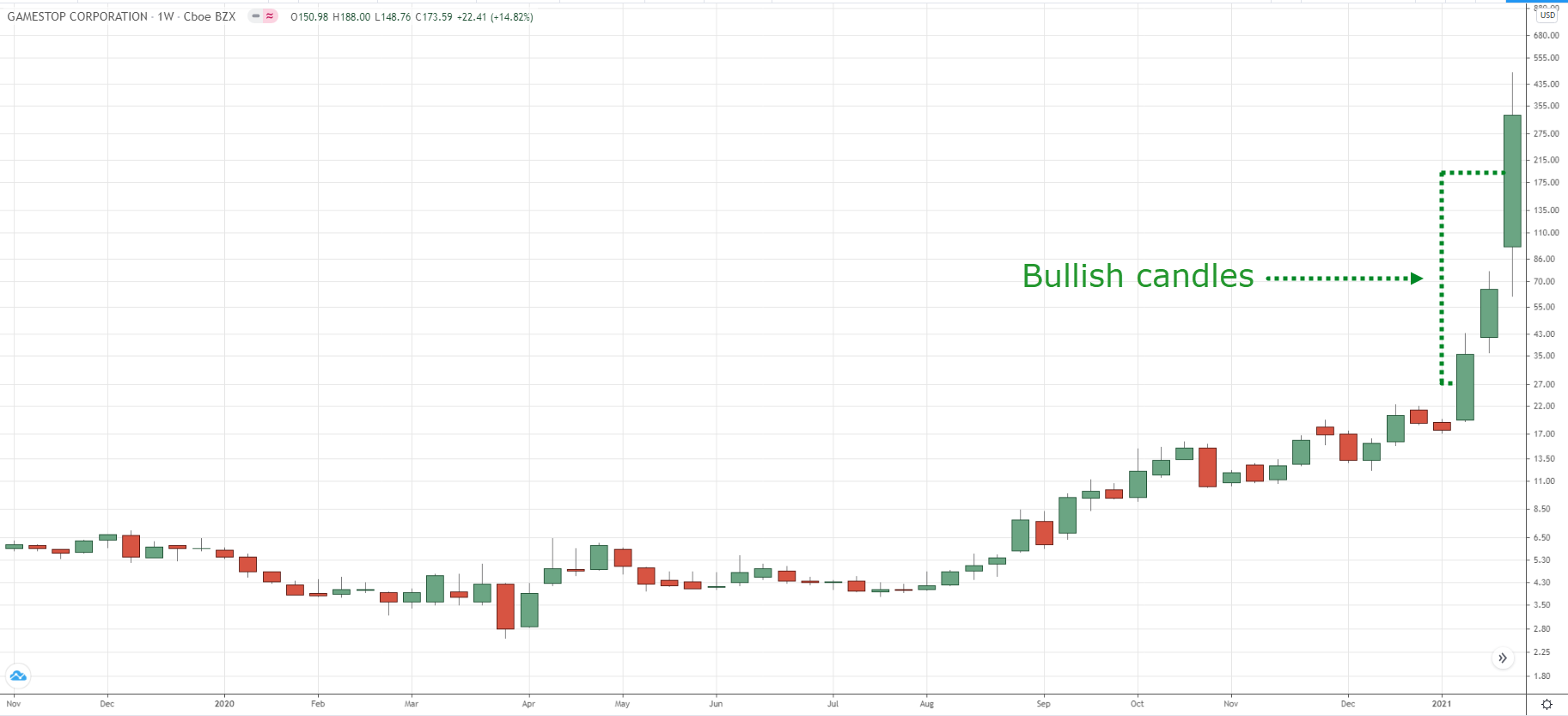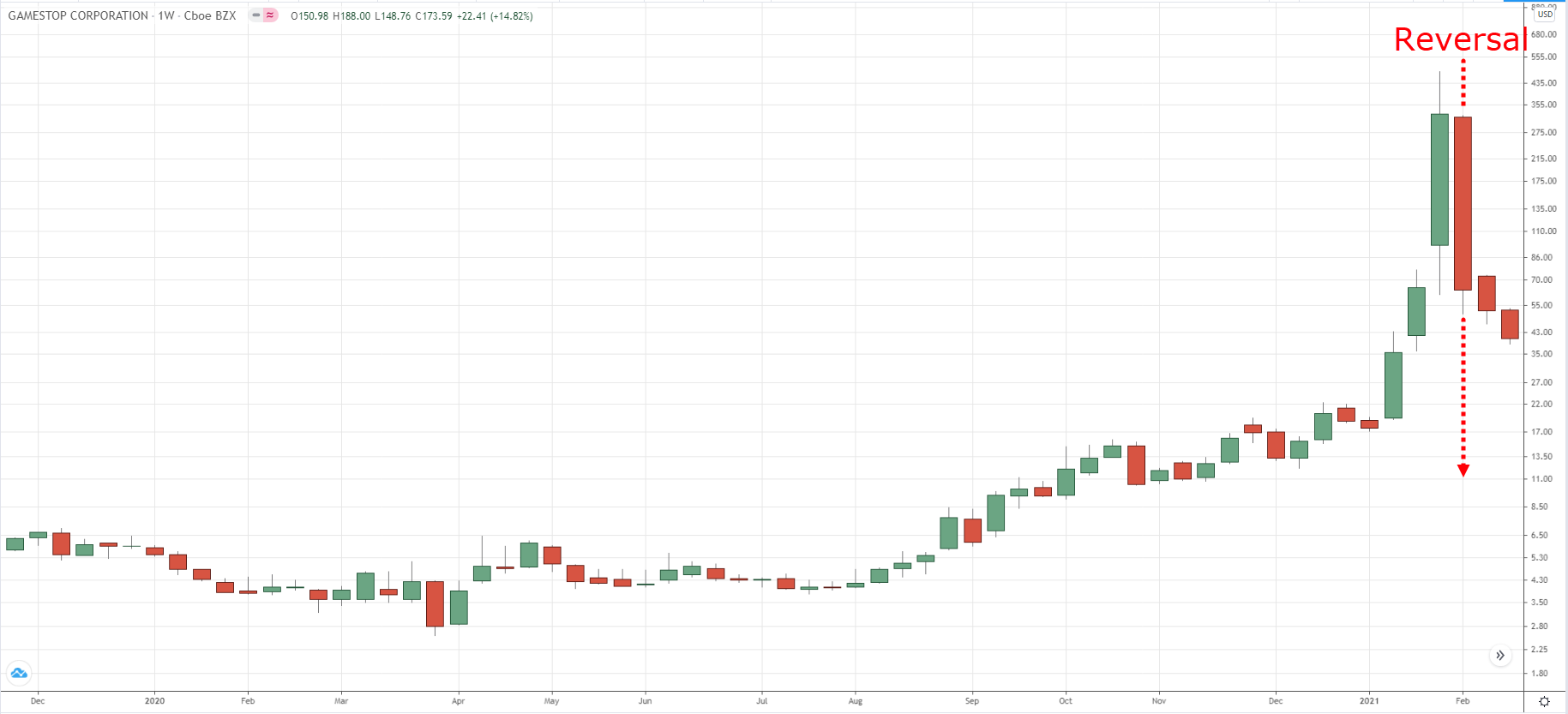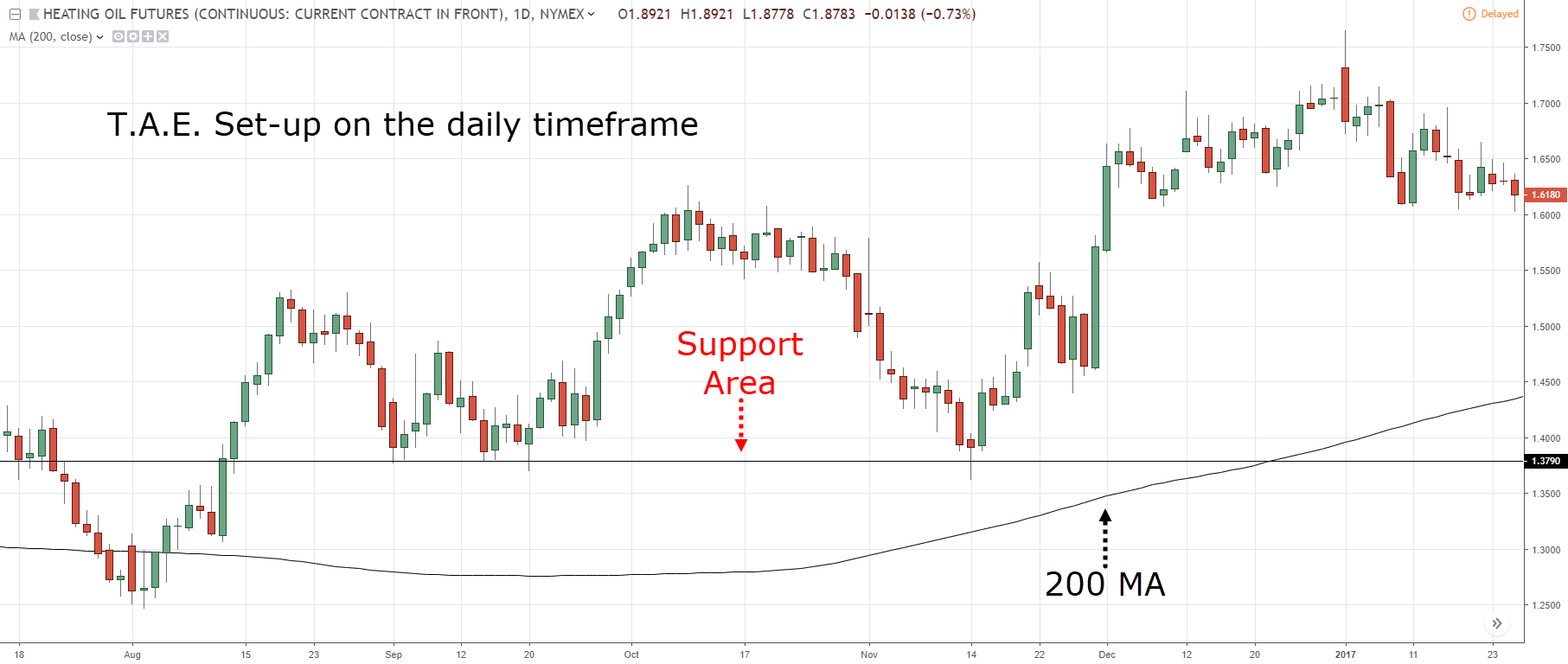Do you find yourself losing money no matter what you do?
You’ve tried candlestick patterns, chart patterns, trading indicators but, none of them makes a difference to your bottom line.
Why?
That’s because the trading strategies and techniques are not the cause of it.
Instead, it’s your trading habits that are doing the most damage.
So here are the 6 trading habits that keep you poor without you realizing it…
#1:You chase the markets
Look at this chart below…
You’re probably thinking:
“Rayner, look at the bullish candles on the chart!”
“It has gone up so many days in a row, this is a big move.”
“Let me quickly place a buy order now before I miss out even more.”
And what do you do?
You hit the buy button, of course.
The next thing you know, this happens…
And that’s the price you pay for chasing the markets.
But why does it happen?
That’s because the market has moved too much too soon.
It needs to take a rest before it continues the climb higher.
So, when you buy near the highs, this is when the market is exhausted and about to make pullback (sometimes even a reversal).
So, if chasing the market is a bad idea.
Then what should you do?
Look to trade from an area of value.
Let me explain…
An area of value refers to an area on your chart where buying pressure could step in and push the price higher (e.g. support, swing low, trendline, etc.).
So if the market is in an uptrend, support could be an area of value.
Here’s an example…
As you can see, trading from an area of value allows you to time your entry when the pullback is about to end.
Also, you can set your stop loss below support which offers you a more favorable risk-to-reward on your trade.
Awesome?
#2: You use a fixed position size
Most traders are fascinated with technical analysis, candlestick patterns, trading indicators, etc.
When you see “something” nice, you quickly hit the buy button without giving much thought to your position size—which is a big mistake.
Why?
Because without proper position sizing, your wins and losses are erratic.
Here’s an example:
Let’s say you buy 1 standard lot of EUR/USD with a stop loss of 20 pips.
How much could you lose?
Well, it’s a potential loss of $200 (20 x $10/pip).
Now, what if you have 100 pips stop loss?
It’s a potential loss of $1000 (100 x $10/pip).
You might be thinking:
“My stop loss in terms of pips will be the same.”
“This way, I can keep my losses constant on each trade.”
That is possible but…
What if you trade a different timeframe where it doesn’t make sense to use the same number of pips as your stop loss? (E.g. A 20 pips stop loss might work on the 5-minutes timeframe but not on the daily.)
Or what if you trade a different currency pair with a different pip value?
Do you see my point?
So the lesson is this…
The size of your losses should be the same for each trade.
But your position size should be adjusted according to the size of your stop loss.
A tighter stop loss allows you to increase your position size.
A wider stop loss requires a smaller position size.
If you want to learn more about position sizing, then go read The Complete Guide to Forex Risk Management and Position Sizing.
#3: You average into losses
Imagine:
You bought 1 lot of EUR/USD at 1.3000.
Shortly, the price dropped 50 pips and you’re down $500.
Now you’re thinking to yourself…
“I knew it, the market is out to get me again.”
“But wait… if I buy another 1 lot of EUR/USD, then I can quickly get out at breakeven if the price moves up 25 pips.”
“I’m a genius!”
So…
You buy another lot of EUR/USD at 1.2950.
Next thing you know, EUR/USD tanked 100 pips—which puts you at a loss of $3,500.
In other words…
If you had cut your loss from the start, it would have only been a loss of $500.
But because you gave in to your emotions and averaged into your losses, it grew into a $3,500 loss.
So the lesson is this:
If the market proves you wrong, get out of the trade.
Don’t average into your losers because it could snowball into something near impossible to recover from.
Pro Tip:
For advanced traders, you can average into your losses to give you a better average price.
But this can only be done after you have considered the risk management aspect of it.
An example:
You can risk 0.3% of your account on your first position.
Another 0.3% on your second position.
A final 0.4% on the last position.
So even if all 3 positions hit your stop loss, it’s only a loss of 1% to your account.
#4: You hesitate to cut your loss
Imagine:
You buy 1 standard lot of GBP/USD at 1.4300 and have a stop loss at 1.4250.
This means if the price drops to 1.4250, you will exit the trade for a loss of $500 (or 50 pips).
Now, this is fine if you allow your stop loss to do its job.
However, you might be thinking…
“I know the market is about to rebound.”
“I’ll look like an idiot if I were to sell right now and only to watch the market reverse higher.”
“Let me hold on the trade for a while longer and sell at the next rally.”
And what happens next?
The market collapsed another 500 pips.
Eventually, the pain is too much to bear and you forced yourself to exit your position.
And because of your hesitation, a $500 loss amplified into $5,500.
So, the bottom line is this…
Honour your stop loss.
It’s there to protect your trading account even though it’ll make you look like a fool once in a while.
#5: You have itchy fingers
Itchy finger refers to entering a trade that’s not part of your trading plan.
That’s because you want excitement from the markets and don’t want to sit on the sidelines doing nothing.
Or perhaps, you’ve no idea what you’re doing so you just place a trade when you feel like it.
Now…
It doesn’t matter if it’s a winning or losing trade because your actions are inconsistent.
And when your actions are inconsistent, you get an inconsistent set of results.
Then you wonder…
“Why are my trading results inconsistent?”
Well, you’ve got your answer now.
So, how do you fix this problem?
#1: Develop a trading plan
A trading plan is a set of rules to guide your trading.
You’ll know what market conditions to trade when to enter, and when to exit your trades—and how to manage your trades from start to finish.
This allows you to have a consistent set of actions over and over again which leads to consistent results.
If you want to learn how to develop a trading plan, go read How To Be A Profitable Trader Within The Next 180 Days.
#2: Make it painful to deviate from your trading plan
Here’s the thing:
Just because you have a trading plan doesn’t mean you won’t have itchy fingers.
Because you might lack the discipline to follow your trading plan even though it’s good for you.
(Kind of like how you don’t eat enough vegetables even though you know it’s good for you.)
The solution?
Be accountable to someone. It could be your spouse, a friend, or someone you trust.
Let them know whenever you deviate from your trading plan, you’ll be penalized.
The penalty could be something like:
- $50 donation to your favourite charity
- Wash the toilets for a week
- Do 100 push-ups
You want to make sure the pain of not following your trading plan is greater than following it.
This way, the mind gravitates toward the least amount of pain which is to follow your trading plan.
This means your actions become consistent and you get consistent results.
Does it make sense?
#6: You listen to others
In today’s age, you can easily access a ton of information from Twitter, Facebook, trading forums, etc.
The problem is…
It hurts your trading results.
Here’s an example. Imagine…
Someone posts a chart on Tesla and explain why he is bullish on it.
Next, there are 100 thumbs up and a flood of comments agreeing with the analysis.
So you quickly buy the stock of Tesla hoping to make a quick profit out of it.
Now here comes the critical part…
What if the price of Tesla drops 30%?
Do you sell, hold, or buy even more?
You don’t know because you’re trading based on the opinion of someone else.
You might be wondering:
“Well, I’ll just ask the original poster for an update on Tesla.”
And he’ll tell you he has sold off his position for a small loss or he doesn’t reply to you.
Either way, you lose.
So, never trade based on the opinion of others.
They won’t tell you how long they plan to hold the trade, when to cut loss, and when to take profit.
Ignore the noise. Believe in yourself.
Conclusion
So here’s what you’ve learned:
- Don’t chase the market because that’s when the market is about to make a pullback or complete reversal
- Adjust your position size relative to the distance of your stop loss. This way, you can always risk the same dollar amount on each trade
- Don’t average into losers. It’s best to take the loss when it’s still small and move on to the next trade
- Cut your loss when the market has proven you wrong—without hesitation
- Never trade out of boredom or itchy finger syndrome
- The opinion of others is noise. Ignore it. Focus on making your own decisions so you are accountable to yourself
Now here’s what I’d like to know…
What’s your #1 trading habit that’s causing your losses?
Leave a comment below and share your thoughts with me.





trading too much
I totally get you.
Thanks Rayner for the good points you tell here.
I think my bad habbets are changing the plan, to quick in a trade and wanted to get losses back. This will not work because you then trade without a plan and emotions wil take over….
Thank you for your honest sharing!
No stop loss.
Time to have one in place
I lose $5 yesterday night because I gained $4 on my last trade simply because I was eager to make another profit on my next trade…
Slow and steady. Cliche but true.
I am quilty of number 1 , chasing the market when it might pullback or reversal thanks for this insight .
Glad you got something out of it!
Chasing after the market and lingering to cut one’s losses
Ouch, feel you!
I always enjoy reading you or watching you talk about FX on YouTube
I appreciate it!
1)Chasing the market
2) lack of indiscipline
3) overtrading
4) do not putting SL
5) lack of emotional trades
Thank you for sharing!
CHASING THE MARKET AND AVERAGE LOSSES ARE THE BIGGEST PROBLEM FOR ME, THANKS FOR THE ADVICE
Thanks for sharing!
The #1 trading habit that caused my loss is that I did not cut my losses when the market proved me wrong also I didn’t observe proper risk management
Hi, my friend.
I think my bad habit is itchy fingers.
I made trading plan objectively. When the trade was running, my psychological area suggested the price would go against me. So I closed it. Not far from this, the price actually went on to my direction. That’s sad..that’s sad. And I mourned for all day long (“Why did I do it? I should have been profitable by these many pips…….”crying on….)
Thank you for sharing, Wahyu. I can relate to that!
trying to buy bottoms in downtrend with leverage, selling naked puts on stock that goes down and stays down for months and keep rolling them over and over seems like forever. example TSLA. first put sold at $760
Thank you for your honest sharing, Sergio.
Chasing trades, refusing to admit I am wrong!
At least you’re honest about it, cheers.
dont know where to start and push button
How apt. I didn’t know where I was going wrong. I was analyzing, working the candles but after every trade the market immediately turned against me… I already felt like they were affecting my chart…. Anyway, I’ve lost all my capital and I think I’m going to give it up…
too soon. keep at it. all will come right with time
Chasing the market and have itchy fingers
Reyna I thank you so much for putting me through, you are my mentor
You are most welcome, Chinonso!
before it was itching fingers, but after blowing accounts monthly and feeling frustrated via the help of a mentor it has finally clicked. relaxed now and can see and trade very clearly
Awesome, Obinna!
thanks a lot always wait your thoughts i am from India nice to meet you Rayner you are one give lot of information
You are welcome, Nakul!
No discipline in terms of exit. Always exit before my target when small pull back happens. In this way, I have lost many big profits.
Thank you for sharing, Dharma.
I hope you learn something from our blog.
Cheers!
Very useful insights.
Thanks, Krish!
Getting out of a position to early
Thank you for sharing, Ian!
Itchy Fingers cause me More Losse…. Thank for Pointing that Mr.Rayner..
You are most welcome, Sathishkumar!
I’ve traded averaging into loses, and that’s the reason why I always suffered blowing my account many times.
Thank you for sharing, Jhanxsh!
Over trading itchy fingers are the trading habit that is causing me loss.
Thank you for sharing, Uchenna!
Need to trade everyday
Trading without a stop loose
Thinking the trade will take longer weather buy or sell
Not following or forgetting the candle patterns then starting trading by assumption
Sometimes not checking weather the patterns are retesting or not before taking a trade
Thank you for sharing, Zinzile!
Itchy fingers
Thanks for sharing, Erick!
Wiser now
Glad to hear that, Arun!
Itchy finger and chasing the market
Thank you for sharing, Eddie!
This is one of the best tips on trading I’ve ever read.
Thanks, Abel!
Total ignorance or lack of proper trading knowledge and lack of self discipline at the highest order. Please Mr. Ryaner I need your coaching
If you are a beginner in trading, I highly recommend you to go through Rayner’s Academy. It is really made for beginners for you to learn the basic in trading.
This will help you out big time!
Here is the link: https://www.tradingwithrayner.com/academy/
Thanks Ryam..these are great tips.I have been making all.these mistakes
You are most welcome, Anne!
Yes bro I don’t have any trading plans, risk management and discipline
Thank you for sharing, Govind!
❤️
Thanks for the love, Gautama!